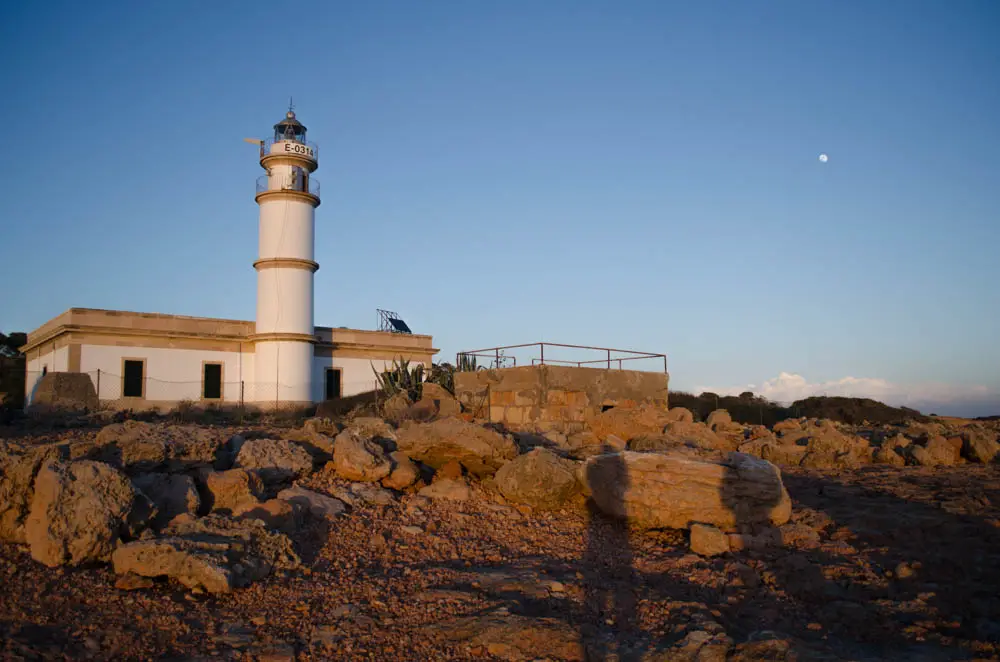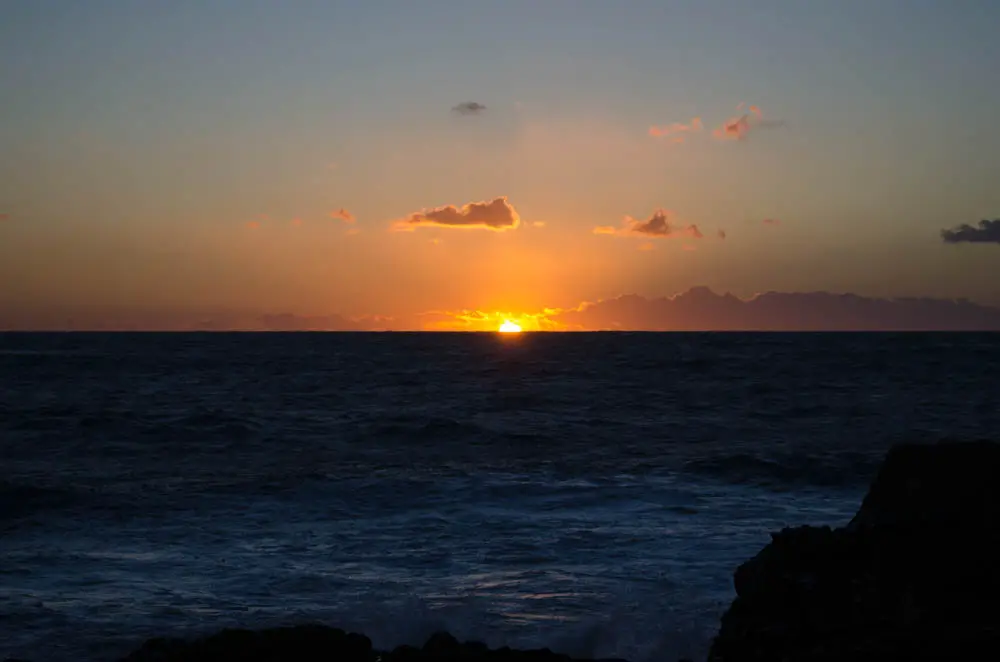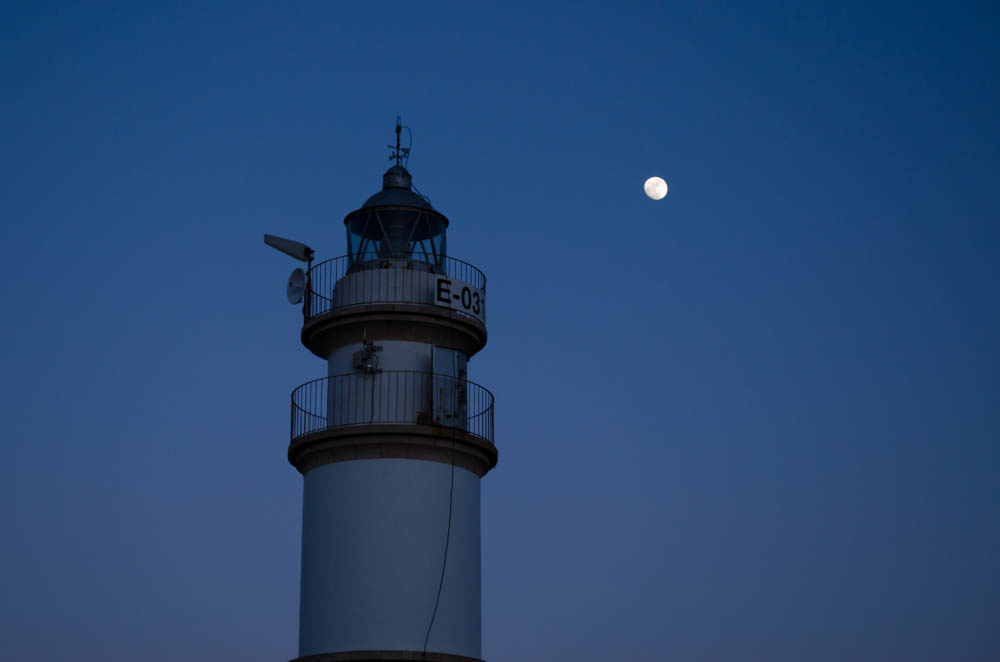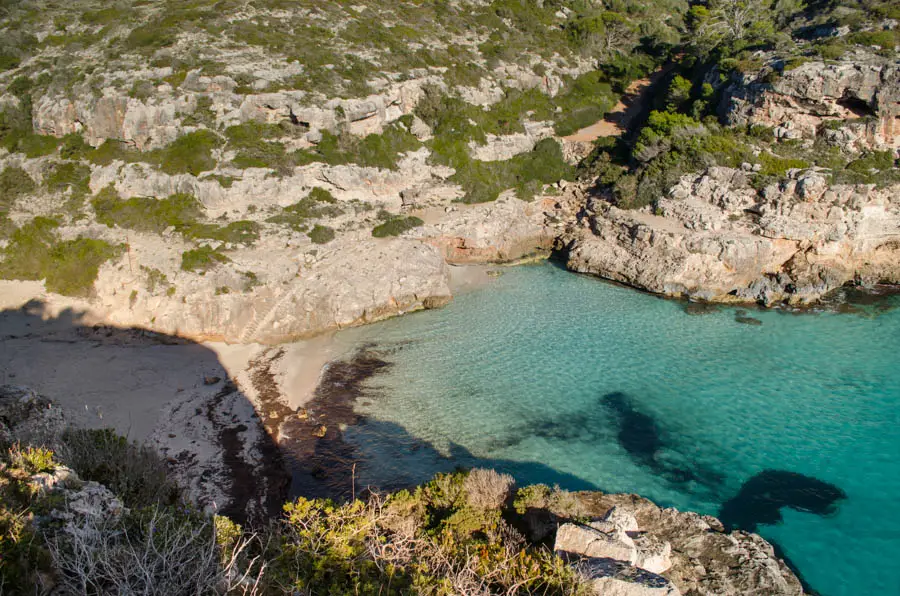You can’t go further south on Mallorca than to Cap de Ses Salines without getting your feet wet. This point is marked by a lighthouse and is a popular destination, especially in the evenings. You’ll also find plenty of opportunities for swimming and hiking.

Transparency note: Some links in this post may lead to external booking opportunities. If a purchase is made, we receive a small commission. The price does not change for you.
Cap de Ses Salines impresses with its breathtaking landscape and the Far de Ses Salines lighthouse, which was built in 1863 and is still operating today. From here, you can enjoy spectacular views of the sea, the nearby island of Cabrera, and the surrounding landscape. Although there is no sandy beach at Cap de Ses Salines itself, there are some options for swimming. With a little more effort, you can even reach relatively secluded beaches in the summer.
How to get to and park at the Cap de Ses Salines
The way to Cap de Ses Salines is quite easy and well signposted on the main road that connects Es Llombards with Ses Salines. What follows is a long, nearly 10-kilometer road, with occasional private property paths branching off to the right and left. Once you see the first parked vehicles, you are relatively close to the southern tip.


“Relatively” because depending on the season, it may still require a short walk on foot. The only parking options are on the side of the road. Parking is free. There is a yellow-lined area directly at the lighthouse where parking is not allowed.
Caution there: Some sections of the roadside have collapsed. And when walking the remaining stretch to the lighthouse, you should pay attention to traffic, as it can be quite narrow at times. But as soon as you pass the lighthouse, the real adventure can begin.
Beaches at the Cap de Ses Salines
Cap de Ses Salines itself is not a beach, but there are some swimming options available. However, most of the coastline is rocky, so it’s always a good idea to have water shoes with you. And you will also have to take a bit of a walk to reach the water.


Due to the fact that the cape is exposed to tides, not only dead seaweed but also sand is washed up in the small rocky coves. This creates and constantly removes small sand beaches that are not recorded anywhere because they are never there long enough. These small beaches are found more frequently to the east of the lighthouse.
To the west of the lighthouse, there is also a spot where there is more sand. However, entering the water is a bit more complicated. Generally, there is no guarantee that you will find a sandy beach. And you should also keep an eye on the sea, as the currents can be somewhat dangerous directly at the southern tip.
More Activities and Hikes at the Cap de Ses Salines
To the south of Cap de Ses Salines, you can see the island of Cabrera. It is not directly accessible from here (the excursion boats start in Colonia de Sant Jordi), but there is a theory about why there are so many stones around the lighthouse. These stones are said to come from Cabrera, where a giant lived who was in a dispute with a giant on Mallorca. The two guys threw stones at each other.
Sunsets at the Cap de Ses Salines
Today, those stones are no longer flying through the air but are being stacked on top of each other by many visitors to create small stone pyramids. This trend has become so popular that at times there were more stone towers than people at the cape.

Environmental groups and local authorities do not approve of the stone towers as they disrupt the geological balance and can harm the natural habitat of animals. However, some people, myself included, find this argument hard to understand, considering the massive urbanization and construction of hotels on the coasts. The main concern is that the towers can cause damage to the ecosystem, especially for small animals like insects and crustaceans that live in the crevices between rocks. Additionally, the towers can cause erosion and affect the natural appearance of the landscape.
Regardless of whether there are stone towers, the best photos at Cap de Ses Salines are taken in the evening hours. The area around the lighthouse is one of the most beautiful places to admire the sunset in Mallorca.


You shouldn’t venture too far from the lighthouse. The coast is not illuminated and once the sun has really disappeared, it can get very dark quickly. Except for the lighthouse, of course, which emits light and can help you orient yourself.
Hiking to Cala Marmols
Tour Details: 9.8 km – 40 altitude – 2 h 30
Cala Marmols is probably one of the last truly secluded beaches in Mallorca, although this is only partly true. The beach is not unknown, but the shortest way to get there is from either Cala S’Almunia or Cap de Ses Salines. From both sides, it’s a little less than 5 kilometers each way.


Furthermore, there is also hardly any shade along the coast. Therefore, especially in summer, it is a rather challenging undertaking that few people undertake. However, at the end, a paradisiacal sandy beach awaits, framed by high cliffs and dense pine forests. To get to Cala Marmols, keep left at the lighthouse and always walk eastward along the sea.
Platja d’es Caragol
Tour Details: 3 km – 1 h
Platja d’es Caragol is somewhat easier to reach. You can get there in just under twenty minutes if you turn right at the lighthouse. Here, too, you always follow the coast until you reach the small boathouse on the Punta Negra. After that, the natural beach begins.


The Es Caragol beach, aside from the walk required to reach it, is the perfect family beach. It is spacious, the water is shallow, and there are old military bunkers in the hinterland that you can climb on.
Sometimes sections of the beach are covered with dead seagrass. This may smell a bit, but it is extremely important for the balance of the ecosystem. The seagrass protects against erosion of the sand. Usually, there are also sections of the beach without seagrass where you can easily access the sea.
Looking for other hikes? Find the best trails on Mallorca here.
The Town of Ses Salines
The cape got its name from the town of Ses Salines, which in turn refers to the salt pans that were already in operation during Roman times. There are about 15 kilometers between Cap de Ses Salines and the salt marshes.
In addition, the southern tip does not even administratively belong to the municipality of Ses Salines, but rather to Santanyí. But that shouldn’t discourage you from visiting. The town is about a 15-minute drive from the lighthouse. On the way there, you’ll also pass by the cactus garden Botanicactus.
Another 8 minutes further, you will reach the entrance to the salt production area. You can buy sea salt in the shop and also participate in small tours. Salt production began in Roman times and was one of the most important economic sectors on the island. If you continue driving on the road next to the salt mountains, you will reach the (paid) parking lot for the beach Playa Es Trenc.
Read more
Want more recommendations like this? Check out more than 100 day trips and excursions on Mallorca.
Planning your holiday on Mallorca:
Book your Flight here
Great Rental Car Offers

